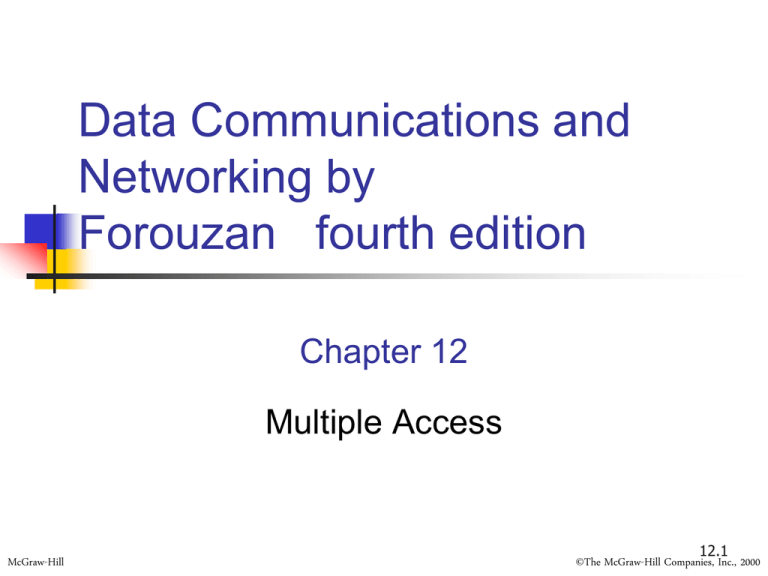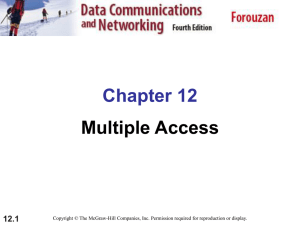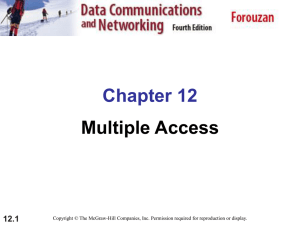Multiple Access Protocols in Data Networks
advertisement

Data Communications and Networking by Forouzan fourth edition Chapter 12 Multiple Access McGraw-Hill 12.1 ©The McGraw-Hill Companies, Inc., 2000 Multiple Access In Chapter 11 we discussed data link control, a mechanism which provides a link with reliable communication. In the protocols we described, we assumed that there is an available dedicated link (or channel) between the sender and the receiver. This assumption may or may not be true. If, indeed, we have a dedicated link, as when we connect to the Internet using PPP as the data link control protocol, then the assumption is true and we do not need anything else. PPP: point-to-point protocol(byte oriented ) which provides connections over multiple links and has a very simple mechanism for error control. 12.2 We can consider the data link layer as two sublayers. The upper sublayer is responsible for data link control and error control is called the logical link control (LLC) layer . The lower sublayer is responsible for resolving access to the shared media is called the media access control (MAC) layer . If the channel is dedicated, we do not need the lower sublayer. Figure 12.1 shows these two sublayers in the data link layer. When nodes or stations are connected and use a common link, called a multipoint or broadcast link, we need a multiple-access protocol to coordinate access to the link. 12.3 Figure 12.1 Data link layer divided into two functionality-oriented sublayers Upper sublayer – responsible for data link control •Called LLC – for flow and error control Lower sublayer - responsible for resolving access the shared media •Called MAC – for multiple acceess resolution 12.4 The problem of controlling the access to the medium is similar to the rules of speaking in an assembly. The procedures guarantee that the right to speak is up held and ensure that two people do not speak at the same time, do not interrupt each other. The situation is similar for multipoint networks. Many formal protocols have been devised to handle access to a shared link. We categorize them into three groups. Protocols belonging to each group are shown in Figure 12.2. 12.5 Figure 12.2 Taxonomy of multiple-access protocols discussed in this chapter 12.6 12-1 RANDOM ACCESS In random access or contention methods, no station is superior to another station and none is assigned the control over another. No station permits, or does not permit, another station to send. At each instance, a station that has data to send uses a procedure defined by the protocol to make a decision on whether or not to send. The decision depends on the state of the medium (idle or busy). Topics discussed in this section: ALOHA Carrier Sense Multiple Access Carrier Sense Multiple Access with Collision Detection Carrier Sense Multiple Access with Collision Avoidance 12.7 12.8 Two features give this method its name. First, there is no scheduled time for a station to transmit. Transmission is random among the stations. That is why these methods are called random access. Second, no rules specify which station should send next. Stations compete with one another to access the medium. That is why these methods are also called contention methods. In a random access method, each station has the right to the medium without being controlled by any other station. However, if more than one station tries to send, there is an access conflictcollision-and the frames will be either destroyed or modified. The random access methods we study a very interesting protocol known as ALOHA, which used a very simple procedure called multiple access(MA), that forces the station to sense the medium before transmitting. ALOHA 12.9 It was designed for a radio (wireless) LAN, but it can be used on any shared medium. The medium is shared between the stations. When a station sends data, another station may attempt to do so at the same time. The data from the two stations collide . The original ALOHA protocol is a simple, but elegant protocol. The idea is that each station sends a frame whenever it has a frame to send. Figure 12.3 shows an example of frame collisions in pure ALOHA. Some of these frames collide because multiple frames are in contention for the shared channel. Figure 12.3 Frames in a pure ALOHA network Pure ALOHA: 1. Each station sends a frame whenever is has a frame to send 2. One channel to share, possibility of collision between frames from different stations 12.10 Figure 12.4 Procedure for pure ALOHA protocol 12.11 Figure 12.5 Vulnerable time for pure ALOHA protocol 12.12 Figure 12.6 Frames in a slotted ALOHA network Slotted ALOHA: 1. We divide the time into slots and force the station to send only at the beginning of the time slot 12.13 Figure 12.7 Vulnerable time for slotted ALOHA protocol 12.14 Carrier Sense Multiple Access (CSMA) 12.15 To minimize the chance of collision and, therefore, increase the performance, the CSMA method was developed. The chance of collision can be reduced if a station senses the medium before trying to use it. CSMA requires that each station first listen to the medium (or check the state of the medium) before sending. it is based on the principle "sense before transmit“. CSMA can reduce the possibility of collision, but it cannot eliminate it. The possibility of collision still exists because of propagation delay. What should a station do if the channel is busy or idle? Three methods have been devised are: I-Persistent The I-persistent method is simple and straightforward. In this method, after the station finds the line idle, it sends its frame immediately (with probability I). This method has the highest chance of collision because two or more stations may find the line idle and send their frames immediately, Ethernet uses this method. Nonpersistent In the nonpersistent method, a station that has a frame to send senses the line. If the line is idle, it sends immediately. If the line is not idle, it waits a random amount of time and then senses the line again. The nonpersistent approach reduces the chance of collision because it is unlikely that two or more stations will wait the same amount of time and retry to send simultaneously. However, this method reduces the efficiency of the network because the medium remains idle when there may be stations with frames to send. 12.16 p-Persistent The p-persistent method is used if the channel has time slots with a slot duration equal to or greater than the maximum propagation time. The p-persistent approach combines the advantages of the other two strategies. It reduces the chance of collision and improves efficiency. 12.17 Figure 12.10 Behavior of three persistence methods 1-Persistent-after station finds the line idle, send its frame Nonpersistent-senses the line; idle: sends immediately; not idle: waits random amount of time and senses again p-Persistent-the channel has time slots with duration equal to or greater than max propagation time 12.18 Figure 12.11 Flow diagram for three persistence methods 12.19 Carrier Sense Multiple Access with Collision Detection (CSMA/CD) 12.20 In this method, a station monitors the medium after it sends a frame to see if the transmission was successful. If so, the station is finished. If, however, there is a collision, the frame is sent again. Example 12.5 (Minimum frame size) A network using CSMA/CD has a bandwidth of 10 Mbps. If the maximum propagation time (including the delays in the devices and ignoring the time needed to send a jamming signal, as we see later) is 25.6 μs, what is the minimum size of the frame? Solution The frame transmission time is Tfr = 2 × Tp = 51.2 μs. This means, in the worst case, a station needs to transmit for a period of 51.2 μs to detect the collision. The minimum size of the frame is 10 Mbps × 51.2 μs = 512 bits or 64 bytes. This is actually the minimum size of the frame for Standard Ethernet. 12.21 Figure 12.14 Flow diagram for the CSMA/CD (Page 375) 12.22 12-2 CONTROLLED ACCESS In controlled access, the stations consult one another to find which station has the right to send. A station cannot send unless it has been authorized by other stations. We discuss three popular controlled-access methods. Topics discussed in this section: Reservation Polling Token Passing 12.23 Reservation In the registration method, a station needs to make a registration before sending data. Time is divided into intervals. In each interval, a reservation frame precedes the data frames sent in that interval. Figure 12.18 shows a situation with five stations and a five-minislot reservation frame. 12.24 Figure 12.18 Reservation access method Reservation-station needs to make a reservation before sending data 12.25 polling 12.26 Polling works with topologies in which one device is designated as a primary station and the other devices are secondary stations. All data exchanges must be made through the primary device even when the ultimate destination is a secondary device. The primary device controls the link; the secondary devices follow its instructions. It is up to the primary device to determine which device is allowed to use the channel at a given time. The primary device, therefore, is always the initiator of a session (see Figure 12-19). Figure 12.19 Select and poll functions in polling access method Polling – one device as primary station and the other device as secondary station Select – primary device wants to send data to secondary device, secondary device gets ready to receive Poll – primary device solicits (ask) transmissions from secondary devices 12.27 The poll function is used by the primary device to solicit transmissions from the secondary devices. When the primary is ready to receive data, it must ask (poll) each device in turn if it has anything to send. When the first secondary is approached, it responds either with a NAK frame if it has nothing to send or with data (in the form of a data frame) if it does. If the response is negative (a NAK frame), then the primary polls the next secondary in the same manner until it finds one with data to send. When the response is positive (a data frame), the primary reads the frame and returns an acknowledgment (ACK frame), verifying its receipt 12.28 Token passing – stations in network organized in a logical ring – predecessor and successor Token – gives station right to access the channel; needs token management Physical ring – station sends the token to successor Dual ring – uses second ring which operates in reverse direction Bus ring (token bus) - stations are connected to single cable called bus, but make logical ring Star ring - physical topology star, wiring inside hub makes the ring 12.29 Figure 12.20 Logical ring and physical topology in token-passing access method 12.30 12-3 CHANNELIZATION (Beyond class scope) Channelization is a multiple-access method in which the available bandwidth of a link is shared in time, frequency, or through code, between different stations. Examples of Channelization: Frequency-Division Multiple Access (FDMA) Time-Division Multiple Access (TDMA) Code-Division Multiple Access (CDMA) 12.31 Frequency-Division Multiple Access (FDMA) 12.32 In frequency-division multiple access (FDMA), the available bandwidth is divided into frequency bands. Each station is allocated a band to send its data. In other words, each band is reserved for a specific station, and it belongs to the station all the time. Each station also uses a bandpass filter to confine the transmitter frequencies. To prevent station interferences, the allocated bands are separated from one another by small guard bands. FDMA, on the other hand, is an access method in the data link layer. The data link layer in each station tells its physical layer to make a bandpass signal from the data passed to it. The signal must be created in the allocated band. Time-Division Multiple Access (TDMA) 12.33 In time-division multiple access (TDMA), the stations share the bandwidth of the channel in time. Each station is allocated a time slot during which it can send data. Each station transmits its data in is assigned time slot. The main problem with TDMA lies in achieving synchronization between the different stations. Each station needs to know the beginning of its slot and the location of its slot. This may be difficult because of propagation delays introduced in the system if the stations are spread over a large area. 12.34 In TDMA, the bandwidth is just one channel that is timeshared between different stations. Code-Division Multiple Access (CDMA) 12.35 Code-division multiple access (CDMA) was conceived several decades ago. Recent advances in electronic technology have finally made its implementation possible. CDMA differs from FDMA because only one channel occupies the entire bandwidth of the link. It differs from TDMA because all stations can send data simultaneously; there is no timesharing. CDMA simply means communication with different codes. For example, in a large room with many people, two people can talk in English if nobody else understands English. Another two people can talk in Chinese if they are the only ones who understand Chinese, and so on. In other words, the common channel, the space of the room in this case, can easily allow communication between several couples, but in different languages (codes).







